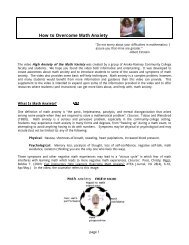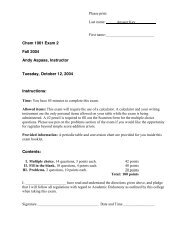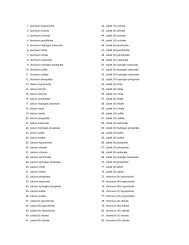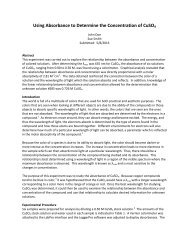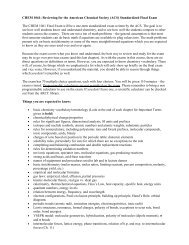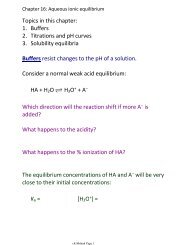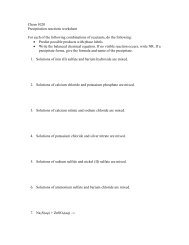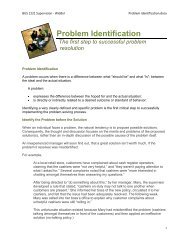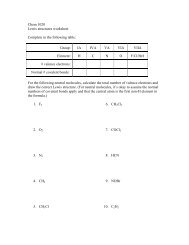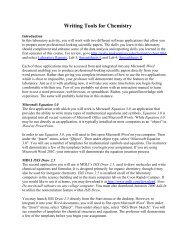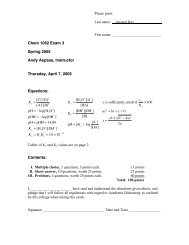ACS ...CHEM 1062: Reviewing for the American Chemical Society ...
ACS ...CHEM 1062: Reviewing for the American Chemical Society ...
ACS ...CHEM 1062: Reviewing for the American Chemical Society ...
- No tags were found...
Create successful ePaper yourself
Turn your PDF publications into a flip-book with our unique Google optimized e-Paper software.
Things you are expected to know (items in italics are first-semester topics):basic chemistry vocabulary/terminology (Look at <strong>the</strong> end of each chapter <strong>for</strong> Important Termsgiven in bold)intermolecular <strong>for</strong>ces, lattice energy, phase transitions, relation of b.p. and m.p. tointermolecular <strong>for</strong>ces, phase diagrams, types of solids, unit cell calculationstypes of solutions, solution concentrations (molarity, molality, %, mole fraction), solubilitycurves, colligative properties, colloids, solubility curves <strong>for</strong> gases vs. curves <strong>for</strong> solidskinetics, instantaneous rates, experimental determination of rate, determining <strong>the</strong> rate lawusing <strong>the</strong> initial rate method, rate constants, elementary reactions, catalysis, reactionmechanisms, collision & transition state <strong>the</strong>ory, activation energy, concentration-timecalculations, temperature and rate, half-lives, graphical determinations of reaction order andrate constant, potential energy diagramschemical equilibrium, equilibrium constant, reaction quotient, LeChatlier’s Principle, predictingreaction direction, calculating equilibrium concentrations, ICE tablesacid-base <strong>the</strong>ories: Arrhenius and Bronsted-Lowry, acid-base strength and relation to molecularstructure, self-ionization of water, and pH , strong and weak acids and basesacid & base ionization equlibria, polyprotic acids, salt solutions, common ion effect, buffers,titration curvessolubility product constant, common ion effect, pH and solubility, precipitation calculations2 nd & 3 rd laws or <strong>the</strong>rmodynamics, entropy and S, free energy and G, spontaneity, relation to<strong>the</strong> equilibrium constant, work, enthalpy and Hbalancing redox reactions, voltaic and electrolytic cells, cell notation, emf, E cell , electrodepotentials, oxidation numbers (know your rules), oxidizing and reducing agents, strength of<strong>the</strong>se agents, applications of electrochemistry, electrolysisfission, fusion, radioactivity, nuclear bombardment reactions, radioactive decay, half-lives,mass-energy calculations, isotopes and nuclide symbols, mass numbers and atomic weights,subatomic particlesg/cm 3 may be written as g∙cm -3 L atmand may be written as L∙atm∙mol -1 ∙K -1molKKnow <strong>the</strong> following equations:md ΔS° = ΣnΔS° (products) - ΣnΔS° (reactants)VM 1 V 1 = M 2 V 2Calculating Molarity, molality, %, mole fractionT f = K f c m and T b = K b c mFormulas <strong>for</strong> equilibrium constant and reaction quotientG o = H o + TS o [H 3 O + ][OH - ] = K w = 1.0×10 -14G o = -RT ln K pH = -log[H 3 O + ]G o = -nFE o cell pOH = -log[OH - ]E o cell =0.0592log KnpH + pOH = 14.000[base]pH = pK a + log [acid]K a K b = K wln NN t = -kt t 1/2 =ΔH° = ΣnΔH° f (products) - ΣnΔH° f (reactants)0.693kRate = kN tΔG° = ΣnΔG° f (products) - ΣnΔG° f (reactants) E = (m)c 2
How Your Final Exam Score Will Be DeterminedThe table below shows how raw scores on <strong>the</strong> <strong>ACS</strong> exam will be converted to scaled final exam scores.The <strong>ACS</strong> standardized exam has 70 questions.In <strong>the</strong> event you are unfamiliar with how percentiles work, an 84 th percentile means that you scoredhigher than 84% of <strong>the</strong> students on <strong>the</strong> national norms and a 25 th percentile means that you scoredhigher than 25% of <strong>the</strong> students taking <strong>the</strong> same exam on <strong>the</strong> national norms. Students scoring in <strong>the</strong>80 th to 100 th percentile will be assigned an "A" score on <strong>the</strong> final, <strong>the</strong> 60 th to 79 th percentile will beassigned a "B", <strong>the</strong> 40 th to 59 th percentile will be assigned a "C", <strong>the</strong> 20 th to 39 th percentile will beassigned a "D", and <strong>the</strong> 0 th to 19 th percentile will be assigned an "F".RawScorePercentileRankingScaledPercentageScaled FinalExam Score70 100 100 20069 100 100 20068 100 100 20067 100 100 20066 100 100 20065 100 100 20064 100 100 20063 100 100 20062 99 99.5 19961 99 99.5 19960 99 99.5 19959 98 99 19858 97 98.5 19757 96 98 19656 95 97.5 19555 94 97 19454 93 96.5 19353 91 95.5 19152 89 94.5 18951 87 93.5 18750 85 92.5 18549 82 91 18248 80 90 18047 77 88.5 17746 74 87 17445 71 85.5 17144 68 84 16843 65 82.5 16542 62 81 16241 60 80 16040 57 78.5 15739 54 77 15438 51 75.5 15137 47 73.5 14736 44 72 14435 41 70.5 141RawScorePercentileRankingScaledPercentageScaled FinalExam Score34 38 69 13833 35 67.5 13532 32 66 13231 30 65 13030 27 63.5 12729 24 62 12428 22 61 12227 19 59.5 11926 17 58 11625 14 55 11024 11 53 <strong>1062</strong>3 9 50 10022 7 48 9621 6 47 9420 5 46 9219 3 45 9018 2 44 8817 2 43 8616 1 42 8415 1 41 8214 0 38 7613 0 36 7212 0 34 6811 0 31 6210 0 28 569 0 25 508 0 23 467 0 20 406 0 17 345 0 14 284 0 11 223 0 8 162 0 5 101 0 2 40 0 0 0



